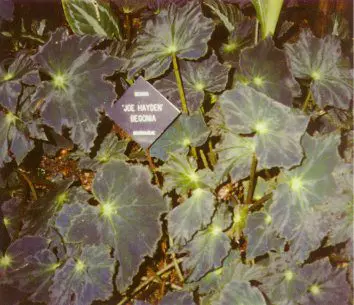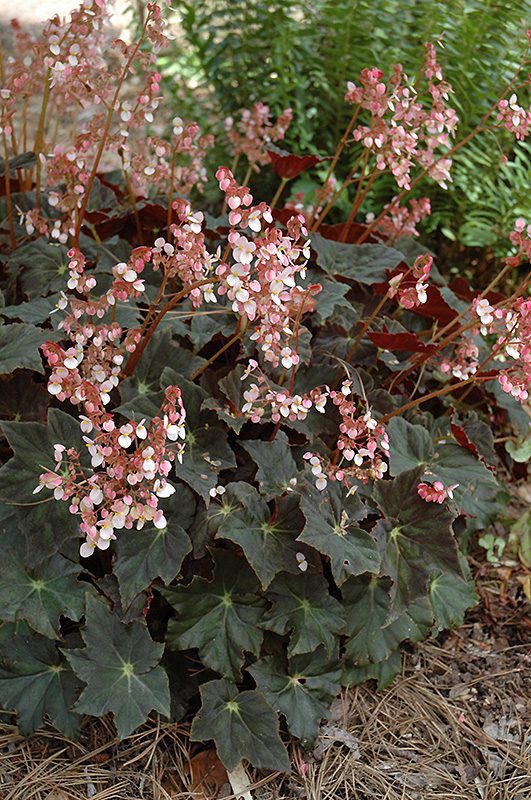My infatuation with B. ‘Joe Hayden’ began sometime in the late spring or early summer of 1971. I remember walking past a flower shop on Third Avenue in New York City during a lunch hour. When I casually looked at the plants displayed in the store’s window, my breath was taken away. I had never seen such an awesome and extraordinary thing! I had to have it! So I simply went inside and bought it. In hindsight, twenty dollars for a plant in 1971 seems like a lot of money. But I was young, recently graduated from college and had no one to whom I had to justify my extravagant purchases. I remember bringing it back to the office where I was working at the time and proudly putting it on the windowsill across from my drafting table. The very stark white architect’s office I was working in desperately needed the color and texture this plant provided!
The plant thrived in the north light of 57 St. and Lexington Avenue. It did so well and grew so big, that it became obvious to me, a mere plant novice, that it was time to divide it.
So I purchased three large clay pots and saucers, along with a bag of perlite, one of a peat-moss, and a third probably of vermiculite.
The next day at lunchtime, I spread out several sheets of newspaper on my drafting table and poured out the contents of these bags. Just when I had finished mixing and mounding, resulting in a mountain of soil, my Boss, Richard Meier, the architect for the now famous Getty Museum in Los Angeles, approached my desk. Surprisingly, he said nothing. He just shook his head and continued to walk by. I cut the very large rhizome into fourths, potted each section and watered them. In a few weeks the plants were ready to give away which I did do.
I don’t remember what happened to the original plant. I certainly took it with me when I left Meier’s office so I must have taken it home with me. In 1980, I moved into a house in Fort Lee, New Jersey; after all, isn’t that what one is supposed to do, move from an apartment to a house? I took some of my plants with me thinking that my youngest sister, who had moved into my apartment would take care of the rest until I picked them up. However, instead of tending them, she ignored them and they all, including ‘Joe Hayden’, died. In the ensuing years, I never tried to replace this plant or any of my other begonias, until…
Twenty-nine years later, two years ago when I read an article about begonias in the Denver Botanic Gardens Newsletter. It mentioned the enormous B. ‘Joe Hayden’ plant inside and to the left of the Garden’s Conservatory entrance. It obviously rekindled a latent obsession and longing within me. I immediately searched for and found the ABS website and asked where I could find ‘Joe’.
Greg Sytch called and gave me the names of a number of mail-order houses to contact. I got in touch with one and ordered B. ‘Joe Hayden’. ‘Joe Hayden’ is now back in my life, along with numerous other begonias. It’s as if he had never left! Thank you, Greg Sytch!
I’ve read in The Begonian that Rudy Ziesenhenne bred it, many years ago.
When Peter sent this article in, he also sent a copy to Rudy Ziesenhenne and asked him who Joe’s parents were and why he named the resulting cross ‘Joe Hayden’. This was his reply: “B. ‘Joe Hayden’ is a cross between B. ‘Reichenheimei’ × B. mazae. Begonia mazae is not rhizomatous, but has thin upright stems about 1/8″ in diameter. It grows upright, but falls over and then tries to grow upright again. However, it has leaves that are dark red below and that makes the leaves (on ‘Joe Hayden’) dark brown. B. ‘Joe Hayden’ was produced in 1947. Mr. Hayden was an early Begonia member who retired and lived in Vista, CA. We had a little contest to see who could find the darkest leaved rhizomatous begonia. In his working life, he was an Englishman who went out from London on to the colonies establishing motion picture theaters in the early days.”
Peter goes on to add: Being a music lover myself, I naturally assumed that the plant was named for the Austrian composer and fellow countryman, Joseph Hayden. I was wrong.



